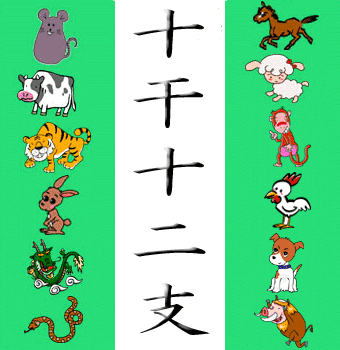
A little while ago, my mum had her 60th birthday. It was such a shame that I could´t be there to celebrate. 60th birthday is one of the biggest birthdays in Japan and is called Kanreki (還暦) in Japanese. This kanji, 還 (kan) means circulate and 暦 (reki) is a calendar and we can understand it as years. So kanreki literary means, your years completed a circle, in other word, you come back to the same year as when you were born.
Still puzzled? This comes from the way ancient Japanese people counted the years. They didn´t use the Gregorian calendar but the lunar calendar and each year was counted with 12 different animals, which is called Junishi (十二支) ; Ne (子/ mouse), Ushi (牛/ cow), Tora (寅/ tiger), U (卯/ rabbit), Tatsu (辰/ dragon), Mi (巳/ snake), Uma (馬/ horse), Hitsuji (未/ sheep), Saru (申/ monkey), Tori (酉/ chicken), Inu (戌/ dog), I (亥/ hog). This is still kept in the modern Japanese life. By the way, this year, 2015 is a year of sheep and the next year 2016 is a year of monkey.

Wait, if there are 12 animals, when it circulate completely, it only takes 12 years and you should be 12 but not 60. Mathematically incorrect. Each year is combined with one of Jikkan (十干), which indicate time and space and there are, Kinoe (甲), Kinoto (乙), Hinoe (丙), Hinoto (丁), Tuchinoe (戊), Tsuchinoto (己), Kanoe (庚), Kanoto (辛), Mizunoe (壬), Mizunoto (癸). For example, this year is a year of sheep and with jikkan, it´s Kinoto Hitsuji (乙未).
The combinations are 60 in total and that is why “kanreki” makes sense as one circle. As the person completes whole 60 combinations, the 60th birthday is also a celebration of re-born. The person will start a new circle of life.
This custom was introduced to Japan in Nara period (奈良時代, 710-794) from China and it was a celebration for the 40th or the 50th birthday among noble people. Back then, 50 years old was very old. Before the WWII, the average life span for Japanese people was 50. The myth Japanese people live long is a quite recent thing and in the ancient time, someone who became 60 years old was a quite special. Perhaps reaching 100 years old nowadays.

60 years old in the present time is nothing. They are still young and many haven´t retired yet. My mum for instance, she is a sporty person and runs 5-10km a few times a week. When she has something to deliver to a friend´s house, she prefers to go running than by bike.
I was planning to buy her a red vest and a hat as a tradition. But she said it would be too old-fashion and didn´t want them.

Why they wear red things to celebrate kanreki?
The colour red is believed to have an effect of protection in Japan and people would put red clothes to new born babies.This vest is called chan-chanko (ちゃんちゃんこ) and is a sleeveless kimono jacket for children. Since Kanreki has a meaning of re-born, people started to give the 60-year-old person a red vest and a hat.
Nowadays, kanreki has become a celebration of showing a gratitude or an appreciation for their work until now instead of celebrating for a long life. Also people tend to give more fun things such as a red tie, a shirt or a scarf.
Named original T-shirt.

Or a red underwear like Spanish people in the New Year´s Eve.

If you don´t know your junishi or jikkan, you can check it from here. Sorry it´s in Japanese though.

Oops, I have to send my mum the card!
References:
What is kanreki? : http://kanreki.info/gift/kanreki.html
Why red chan-chanko? : http://www.ringbell.co.jp/giftconcierge/1956
Junishi Jikkan : http://www.yk.rim.or.jp/~makoto96/eto.html
